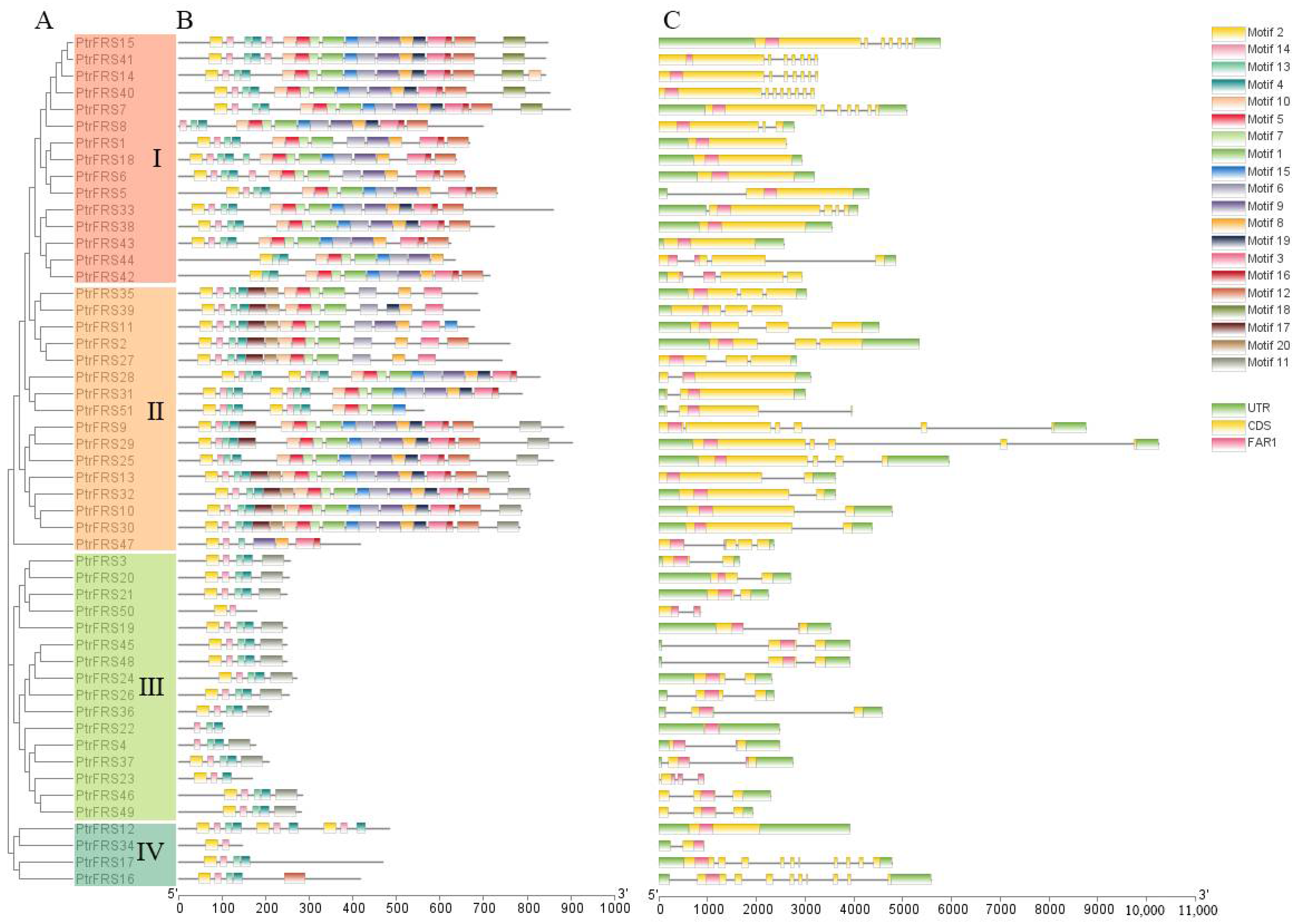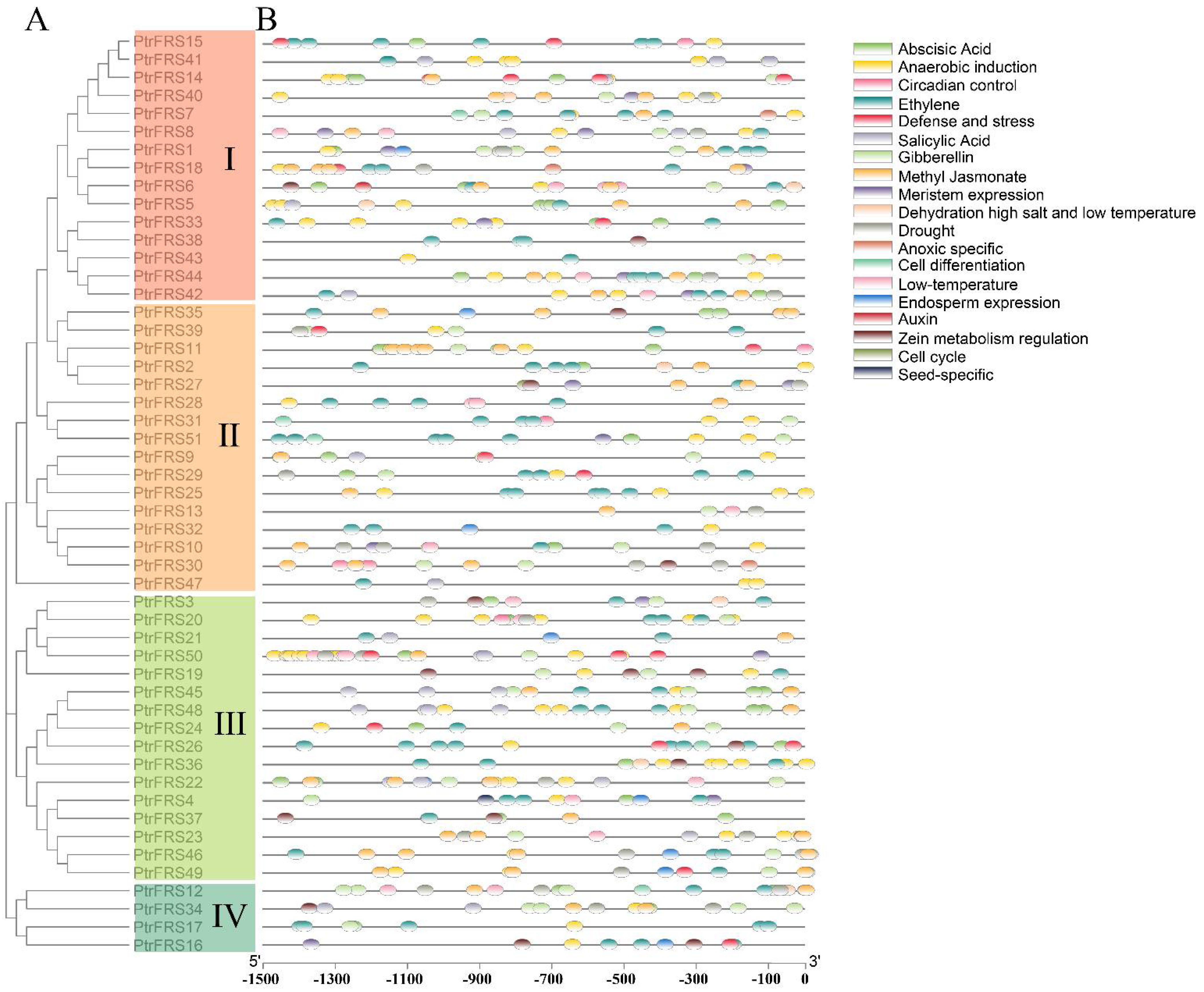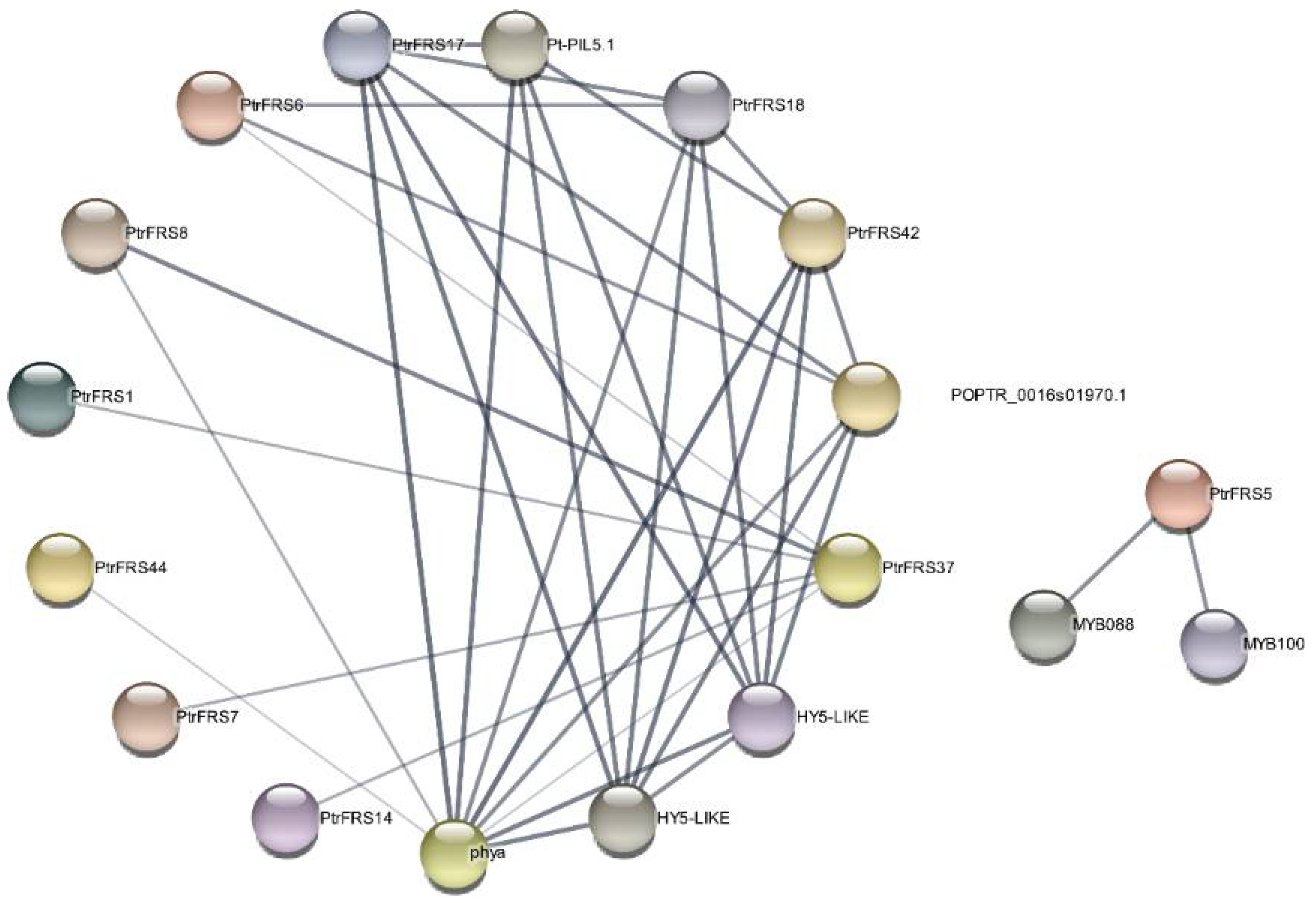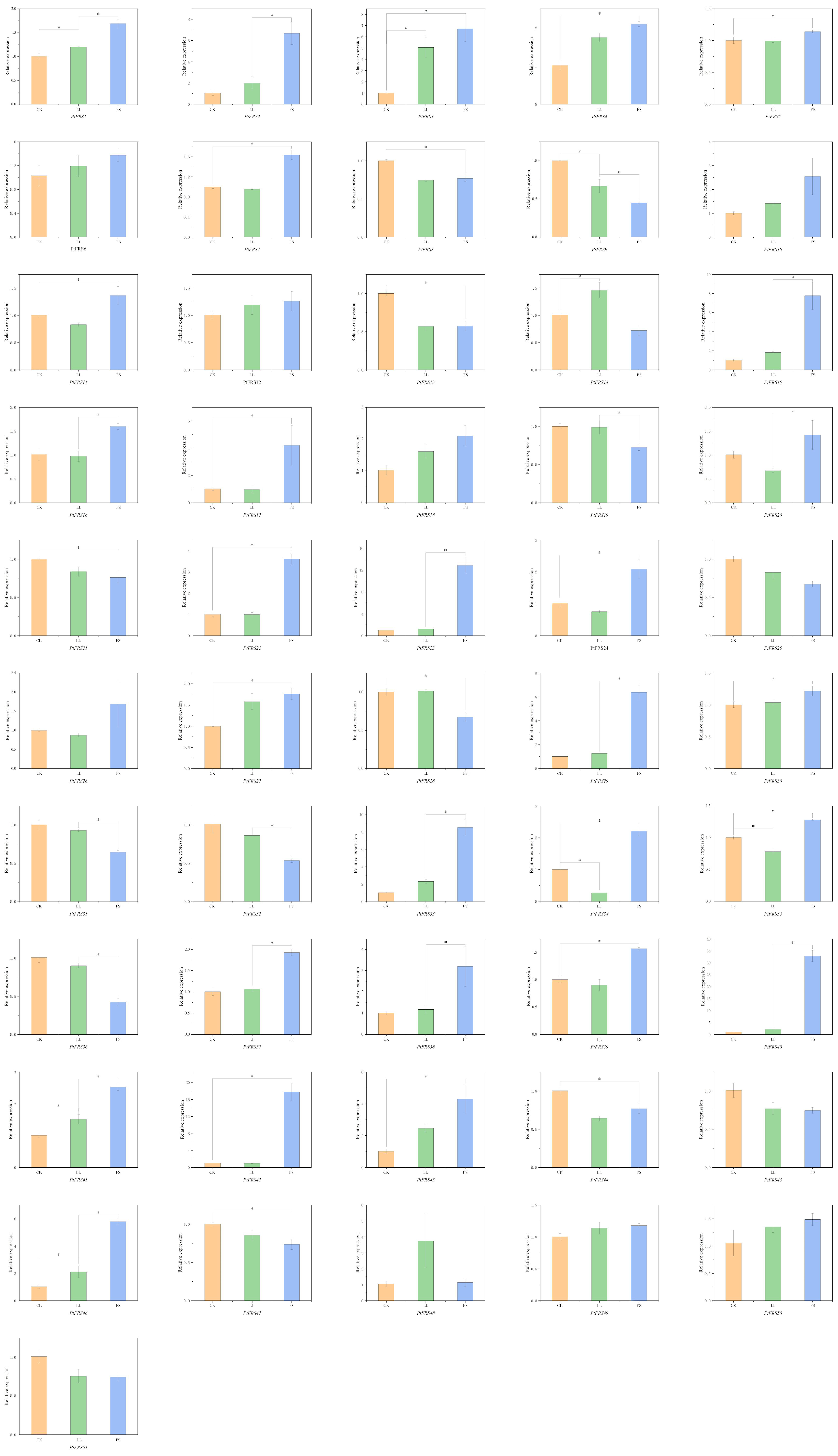Genome-Wide Identification and Characterization of the FAR1/FHY3 Family in Populus trichocarpa Torr. & Gray and Expression Analysis in Light Response
Abstract
:1. Introduction
2. Methods
2.1. Plant Materials
2.2. Identification, Characteristic, and Location Analysis of PtrFRSs
2.3. Sequence Alignment and Phylogenetic Construction Tree of PtrFRSs
2.4. Structural Analysis of PtrFRSs
2.5. Analysis of Cis-Acting Elements in the Promoter Regions of PtrFRSs
2.6. Prediction of the Protein–Protein Interaction Network of PtrFRSs
2.7. RNA Isolation and Expression Analysis of PtrFRSs Genes of Light Response
3. Results
3.1. Identification and Chromosomal Locations of PtrFRSs
3.2. Phylogenetic Classification and Subfamily Division of PtrFRSs
3.3. Cis-Acting Elements of the PtrFRSs Promoters
3.4. Prediction of the Protein–Protein Interaction Network
3.5. Transcriptional Expression of PtrFRSs Genes during Light Repones
4. Discussion
4.1. Identification and Molecular Features of PtrFRS Proteins
4.2. Potential Regulatory of PtrFRSs
5. Conclusions
Supplementary Materials
Author Contributions
Funding
Institutional Review Board Statement
Informed Consent Statement
Data Availability Statement
Acknowledgments
Conflicts of Interest
References
- Rausenberger, J.; Tscheuschler, A.; Nordmeier, W.; Wust, F.; Timmer, J.; Schafer, E.; Fleck, C.; Hiltbrunner, A. Photoconversion and nuclear trafficking cycles determine phytochrome A’s response profile to far-red light. Cell 2011, 146, 813–825. [Google Scholar] [CrossRef] [PubMed] [Green Version]
- Bae, G.; Choi, G. Decoding of light signals by plant phytochromes and their interacting proteins. Annu. Rev. Plant Biol. 2008, 59, 281–311. [Google Scholar] [CrossRef] [Green Version]
- Botto, J.F.U.D.; Sanchez, R.A.; Whitelam, G.C.; Casal, J.J. Phytochrome A mediates the promotion of seed germination by very low fluences of light and canopy shade light in Arabidopsis. Plant Physiol. 1996, 110, 439–444. [Google Scholar] [CrossRef] [Green Version]
- Quail, P.H.; Boylan, M.T.; Parks, B.M.; Short, T.W.; Xu, Y.; Wagner, D. Phytochromes: Photosensory perception and signal transduction. Science 1995, 268, 675–680. [Google Scholar] [CrossRef]
- Kim, L.; Kircher, S.; Toth, R.; Adam, E.; Schafer, E.; Nagy, F. Light-induced nuclear import of phytochrome-A: GFP fusion proteins is differentially regulated in transgenic tobacco and Arabidopsis. Plant J. 2000, 22, 125–133. [Google Scholar] [CrossRef] [Green Version]
- Kircher, S.; Gil, P.; Kozma-Bognar, L.; Fejes, E.; Speth, V.; Husselstein-Muller, T.; Bauer, D.; Adam, E.; Schafer, E.; Nagy, F. Nucleocytoplasmic partitioning of the plant photoreceptors phytochrome A, B, C, D, and E is regulated differentially by light and exhibits a diurnal rhythm. Plant Cell 2002, 14, 1541–1555. [Google Scholar] [CrossRef] [Green Version]
- Kevei, E.; Schafer, E.; Nagy, F. Light-regulated nucleo-cytoplasmic partitioning of phytochromes. J. Exp. Bot. 2007, 58, 3113–3124. [Google Scholar] [CrossRef]
- Lin, R.; Ding, L.; Casola, C.; Ripoll, D.R.; Feschotte, C.; Wang, H. Transposase-Derived Transcription Factors Regulate Light Signaling in Arabidopsis. Science 2007, 318, 1302–1305. [Google Scholar] [CrossRef] [Green Version]
- Huan, L.; Wang, X.X.; Liu, W.; Li, L.; Gao, D. Expression Analysis of FAR1/FHY3-related Genes Involved in Nectarine Floral Buds during Dormancy Induction. J. Shandong Agric. Univ. (Nat. Sci. Ed.) 2017, 48, 229–235. [Google Scholar]
- Siddiqui, H.; Khan, S.; Rhodes, B.M.; Devlin, P.F. FHY3 and FAR1 Act Downstream of Light Stable Phytochromes. Front. Plant Sci. 2016, 7, 175. [Google Scholar] [CrossRef] [Green Version]
- Wang, W.; Tang, W.; Ma, T.; Niu, D.; Jin, J.B.; Wang, H.; Lin, R. A pair of light signaling factors FHY3 and FAR1 regulates plant immunity by modulating chlorophyll biosynthesis. J. Integr. Plant Biol. 2016, 58, 91–103. [Google Scholar] [CrossRef]
- Liu, Y.; Ma, M.; Li, G.; Yuan, L.; Xie, Y.; Wei, H.; Ma, X.; Li, Q.; Devlin, P.F.; Xu, X.; et al. Transcription Factors FHY3 and FAR1 Regulate Light-Induced CIRCADIAN CLOCK ASSOCIATED1 Gene Expression in Arabidopsis. Plant Cell 2020, 32, 1464–1478. [Google Scholar] [CrossRef]
- Xie, Y.; Zhou, Q.; Zhao, Y.; Li, Q.; Liu, Y.; Ma, M.; Wang, B.; Shen, R.; Zheng, Z.; Wang, H. FHY3 and FAR1 Integrate Light Signals with the miR156-SPL Module-Mediated Aging Pathway to Regulate Arabidopsis Flowering. Mol. Plant 2020, 13, 483–498. [Google Scholar] [CrossRef] [PubMed] [Green Version]
- Wu, Q.; Bai, X.; Zhao, W.; Shi, X.; Xiang, D.; Wan, Y.; Wu, X.; Sun, Y.; Zhao, J.; Peng, L.; et al. Investigation into the underlying regulatory mechanisms shaping inflorescence architecture in Chenopodium quinoa. BMC Genom. 2019, 20, 658. [Google Scholar] [CrossRef] [PubMed]
- Li, H.; Wang, L.; Mai, Y.; Han, W.; Suo, Y.; Diao, S.; Sun, P.; Fu, J. Phytohormone and integrated mRNA and miRNA transcriptome analyses and differentiation of male between hermaphroditic floral buds of andromonoecious Diospyros kaki Thunb. BMC Genom. 2021, 22, 203. [Google Scholar] [CrossRef] [PubMed]
- Ma, L.; Li, G. Arabidopsis FAR-RED ELONGATED HYPOCOTYL3 negatively regulates carbon starvation responses. Plant Cell Environ. 2021, 44, 1816–1829. [Google Scholar] [CrossRef] [PubMed]
- Ma, L.; Xue, N.; Fu, X.; Zhang, H.; Li, G. Arabidopsis thaliana FAR-RED ELONGATED HYPOCOTYLS3 (FHY3) and FAR-RED-IMPAIRED RESPONSE1 (FAR1) modulate starch synthesis in response to light and sugar. New Phytol. 2017, 213, 1682–1696. [Google Scholar] [CrossRef]
- Xie, Y.; Liu, Y.; Ma, M.; Zhou, Q.; Zhao, Y.; Zhao, B.; Wang, B.; Wei, H.; Wang, H. Arabidopsis FHY3 and FAR1 integrate light and strigolactone signaling to regulate branching. Nat. Commun. 2020, 11, 1955. [Google Scholar] [CrossRef] [PubMed] [Green Version]
- Bryant, N.D.; Pu, Y.; Tschaplinski, T.J.; Tuskan, G.A.; Muchero, W.; Kalluri, U.C.; Yoo, C.G.; Ragauskas, A.J. Transgenic Poplar Designed for Biofuels. Trends Plant Sci. 2020, 25, 881–896. [Google Scholar] [CrossRef]
- Kucharska, K.; Łukajtis, R.; Słupek, E.; Cieśliński, H.; Rybarczyk, P.; Kamiński, M. Hydrogen Production from Energy Poplar Preceded by MEA Pre-Treatment and Enzymatic Hydrolysis. Molecules 2018, 23, 3029. [Google Scholar] [CrossRef] [Green Version]
- Taylor, G. Populus: Arabidopsis for forestry. Do we need a model tree? Ann. Bot. 2002, 90, 681–689. [Google Scholar] [CrossRef] [PubMed] [Green Version]
- Tuskan, G.A.; DiFazio, S.; Jansson, S.; Bohlmann, J.; Grigoriev, I.; Hellsten, U.; Putnam, N.; Ralph, S.; Rombauts, S.; Salamov, A.; et al. The Genome of Black Cottonwood, Populus trichocarpa (Torr. & Gray). Science 2006, 313, 1596–1604. [Google Scholar] [PubMed] [Green Version]
- Wullschleger, S.D.; Tuskan, G.A.; DiFazio, S.P. Genomics and the tree physiologist. Tree Physiol. 2002, 22, 1273–1276. [Google Scholar] [CrossRef] [PubMed] [Green Version]
- Liu, Q.; Ding, C.; Chu, Y.; Chen, J.; Zhang, W.; Zhang, B.; Huang, Q.; Su, X. PoplarGene: Poplar gene network and resource for mining functional information for genes from woody plants. Sci. Rep. 2016, 6, 31356. [Google Scholar] [CrossRef] [Green Version]
- Lin, R.; Wang, H. Arabidopsis FHY3/FAR1 gene family and distinct roles of its members in light control of Arabidopsis development. Plant Physiol. 2004, 136, 4010–4022. [Google Scholar] [CrossRef] [Green Version]
- Liu, Z.; An, C.; Zhao, Y.; Xiao, Y.; Bao, L.; Gong, C.; Gao, Y. Genome-Wide Identification and Characterization of the CsFHY3/FAR1 Gene Family and Expression Analysis under Biotic and Abiotic Stresses in Tea Plants (Camellia sinensis). Plants 2021, 10, 570. [Google Scholar] [CrossRef]
- El-Gebali, S.; Mistry, J.; Bateman, A.; Eddy, S.R.; Luciani, A.; Potter, S.C.; Qureshi, M.; Richardson, L.J.; Salazar, G.A.; Smart, A.; et al. The Pfam protein families database in 2019. Nucleic Acids Res. 2019, 47, D427–D432. [Google Scholar] [CrossRef]
- Johnson, L.S.; Eddy, S.R.; Portugaly, E. Hidden Markov model speed heuristic and iterative HMM search procedure. BMC Bioinform. 2010, 11, 431. [Google Scholar] [CrossRef] [Green Version]
- Letunic, I.; Khedkar, S.; Bork, P. SMART: Recent updates, new developments and status in 2020. Nucleic Acids Res. 2021, 49, D458–D460. [Google Scholar] [CrossRef]
- Wilkins, M.R.; Gasteiger, E.; Bairoch, A.; Sanchez, J.C.; Williams, K.L.; Appel, R.D.; Hochstrasser, D.F. Protein identification and analysis tools in the ExPASy server. Methods Mol. Biol. 1999, 112, 531–552. [Google Scholar]
- Chen, C.J.; Chen, H.; Zhang, Y.; Thomas, H.R.; Frank, M.H.; He, Y.H.; Xia, R. TBtools: An integrative toolkit developed for interactive analyses of big biological data. Mol. Plant 2020, 13, 1194–1202. [Google Scholar] [CrossRef]
- Bailey, T.L.; Boden, M.; Buske, F.A.; Frith, M.; Grant, C.E.; Clementi, L.; Ren, J.; Li, W.W.; Noble, W.S. MEME SUITE: Tools for motif discovery and searching. Nucleic Acids Res. 2009, 37, W202–W208. [Google Scholar] [CrossRef]
- Lescot, M.; Dehais, P.; Thijs, G.; Marchal, K.; Moreau, Y.; Van de Peer, Y.; Rouze, P.; Rombauts, S. PlantCARE, a database of plant cis-acting regulatory elements and a portal to tools for in silico analysis of promoter sequences. Nucleic Acids Res. 2002, 30, 325–327. [Google Scholar] [CrossRef]
- Szklarczyk, D.; Gable, A.L.; Lyon, D.; Junge, A.; Wyder, S.; Huerta-Cepas, J.; Simonovic, M.; Doncheva, N.T.; Morris, J.H.; Bork, P.; et al. STRING v11: Protein-protein association networks with increased coverage, supporting functional discovery in genome-wide experimental datasets. Nucleic Acids Res. 2019, 47, D607–D613. [Google Scholar] [CrossRef] [Green Version]
- Hudson, M.; Ringli, C.; Boylan, M.T.; Quail, P.H. The FAR1 locus encodes a novel nuclear protein specific to phytochrome A signaling. Genes Dev. 1999, 13, 2017–2027. [Google Scholar] [CrossRef] [Green Version]
- Wang, H.; Deng, X.W. Arabidopsis FHY3 defines a key phytochrome A signaling component directly interacting with its homologous partner FAR1. EMBO J. 2002, 21, 1339–1349. [Google Scholar] [CrossRef] [PubMed] [Green Version]
- Jeffares, D.C.; Penkett, C.J.; Bahler, J. Rapidly regulated genes are intron poor. Trends Genet. 2008, 24, 375–378. [Google Scholar] [CrossRef]
- Gangappa, S.N.; Botto, J.F. The Multifaceted Roles of HY5 in Plant Growth and Development. Mol. Plant 2016, 9, 1353–1365. [Google Scholar] [CrossRef] [Green Version]
- Wu, M.; Liu, D.; Abdul, W.; Upreti, S.; Liu, Y.; Song, G.; Wu, J.; Liu, B.; Gan, Y. PIL5 represses floral transition in Arabidopsis under long day conditions. Biochem. Biophys. Res. Commun. 2018, 499, 513–518. [Google Scholar] [CrossRef] [PubMed]
- Kamiya, T.; Borghi, M.; Wang, P.; Danku, J.M.C.; Kalmbach, L.; Hosmani, P.S.; Naseer, S.; Fujiwara, T.; Geldner, N.; Salt, D.E. The MYB36 transcription factor orchestrates Casparian strip formation. Proc. Natl. Acad. Sci. USA 2015, 112, 10533–10538. [Google Scholar] [CrossRef] [PubMed] [Green Version]
- Liberman, L.M.; Sparks, E.E.; Moreno-Risueno, M.A.; Petricka, J.J.; Benfey, P.N. MYB36 regulates the transition from proliferation to differentiation in the Arabidopsis root. Proc. Natl. Acad. Sci. USA 2015, 112, 12099–12104. [Google Scholar] [CrossRef] [PubMed] [Green Version]






| Gene ID | Phytozome ID | Chr Location | Protein | Subcellular Localization | Signal Pep | |||
|---|---|---|---|---|---|---|---|---|
| Length | Mw | pI | GRAVY | |||||
| PtrFRS1 | Potri.001G201600 | 1 | 669 | 77,238.95 | 5.74 | −0.426 | Nucleus | NO |
| PtrFRS2 | Potri.002G199300 | 2 | 759 | 86,585.61 | 5.95 | −0.321 | Nucleus | NO |
| PtrFRS3 | Potri.002G239300 | 2 | 257 | 30,079.92 | 5.27 | −0.721 | Nucleus | NO |
| PtrFRS4 | Potri.002G239400 | 2 | 178 | 20,460.26 | 9.61 | −0.83 | Nucleus | NO |
| PtrFRS5 | Potri.003G031200 | 3 | 732 | 85,391.06 | 5.09 | −0.566 | Nucleus | NO |
| PtrFRS6 | Potri.003G031400 | 3 | 658 | 76,223.95 | 8.1 | −0.429 | Nucleus | NO |
| PtrFRS7 | Potri.003G110300 | 3 | 897 | 103,330.62 | 8.3 | −0.691 | Nucleus | NO |
| PtrFRS8 | Potri.003G207100 | 3 | 748 | 86,459.71 | 6.81 | −0.567 | Nucleus | NO |
| PtrFRS9 | Potri.004G196300 | 4 | 883 | 99,461.92 | 6.22 | −0.495 | Nucleus | NO |
| PtrFRS10 | Potri.004G209000 | 4 | 789 | 90,574.94 | 6.37 | −0.563 | Nucleus | NO |
| PtrFRS11 | Potri.004G227600 | 4 | 679 | 78,035.73 | 7.89 | −0.435 | Nucleus | NO |
| PtrFRS12 | Potri.005G023700 | 5 | 484 | 54,628.34 | 7.81 | −0.877 | Nucleus | NO |
| PtrFRS13 | Potri.005G257600 | 5 | 759 | 86,814.74 | 6.06 | −0.495 | Nucleus | NO |
| PtrFRS14 | Potri.006G020600 | 6 | 842 | 97,070.98 | 6.67 | −0.548 | Cytoplasm | NO |
| PtrFRS15 | Potri.006G020700 | 6 | 846 | 96,918.04 | 7.06 | −0.674 | Cytoplasm | NO |
| PtrFRS16 | Potri.006G039700 | 6 | 417 | 46,188.23 | 9.29 | −0.312 | Nucleus | NO |
| PtrFRS17 | Potri.006G039800 | 6 | 470 | 51,097.48 | 8.7 | −0.267 | Nucleus | NO |
| PtrFRS18 | Potri.006G256300 | 6 | 670 | 77,830.43 | 6.27 | −0.469 | Nucleus | NO |
| PtrFRS19 | Potri.007G128700 | 7 | 248 | 28,544.49 | 5.61 | −0.535 | Cytoplasm | NO |
| PtrFRS20 | Potri.007G128800 | 7 | 253 | 29,360.94 | 5.75 | −0.895 | Cytoplasm | NO |
| PtrFRS21 | Potri.007G128900 | 7 | 248 | 28,675.98 | 5.46 | −0.923 | Nucleus | NO |
| PtrFRS22 | Potri.007G129000 | 7 | 107 | 12,473.45 | 10.06 | −0.717 | Nucleus | NO |
| PtrFRS23 | Potri.007G129100 | 7 | 169 | 19,509.57 | 8.93 | −0.534 | Nucleus | NO |
| PtrFRS24 | Potri.007G129500 | 7 | 273 | 31,258.18 | 5.72 | −0.662 | Nucleus | NO |
| PtrFRS25 | Potri.008G011800 | 8 | 860 | 97,563.17 | 6.06 | −0.432 | Peroxisomes | NO |
| PtrFRS26 | Potri.008G076800 | 8 | 255 | 28,646.2 | 7.09 | −0.762 | Nucleus | NO |
| PtrFRS27 | Potri.008G108800 | 8 | 742 | 84,679.09 | 5.73 | −0.326 | Nucleus | NO |
| PtrFRS28 | Potri.008G199300 | 8 | 830 | 95,699.09 | 8.21 | −0.594 | Nucleus | NO |
| PtrFRS29 | Potri.009G158400 | 9 | 902 | 100,979.55 | 6.18 | −0.476 | Nucleus | NO |
| PtrFRS30 | Potri.009G170100 | 9 | 784 | 89,932.74 | 6.99 | −0.502 | Nucleus | NO |
| PtrFRS31 | Potri.010G029000 | 10 | 788 | 90,350.18 | 8.72 | −0.514 | Nucleus | NO |
| PtrFRS32 | Potri.011G145800 | 11 | 807 | 92,308.16 | 6.33 | −0.509 | Nucleus | NO |
| PtrFRS33 | Potri.012G137500 | 12 | 861 | 99,483.87 | 5.88 | −0.584 | Nucleus | NO |
| PtrFRS34 | Potri.013G014000 | 13 | 148 | 16,491.42 | 7.73 | −0.939 | Nucleus | NO |
| PtrFRS35 | Potri.014G167000 | 14 | 686 | 79,495.16 | 5.95 | −0.413 | Chloroplast | NO |
| PtrFRS36 | Potri.014G176500 | 14 | 214 | 24,735.01 | 8.39 | −0.866 | Nucleus | NO |
| PtrFRS37 | Potri.014G176600 | 14 | 207 | 23,296.23 | 6.26 | −0.71 | Nucleus | NO |
| PtrFRS38 | Potri.015G139300 | 15 | 725 | 83,760.73 | 6.02 | −0.532 | Nucleus | NO |
| PtrFRS39 | Potri.016G007300 | 16 | 691 | 80,354.36 | 5.87 | −0.415 | Nucleus | NO |
| PtrFRS40 | Potri.016G018100 | 16 | 853 | 96,769.58 | 5.95 | −0.43 | Nucleus | NO |
| PtrFRS41 | Potri.016G018300 | 16 | 843 | 96,537.65 | 7.09 | −0.685 | Nucleus | NO |
| PtrFRS42 | Potri.016G058500 | 16 | 714 | 81,170.66 | 4.89 | −0.518 | Nucleus | NO |
| PtrFRS43 | Potri.016G058700 | 16 | 625 | 72,679.85 | 7.21 | −0.478 | Nucleus | NO |
| PtrFRS44 | Potri.016G059100 | 16 | 634 | 72,139.35 | 4.79 | −0.538 | Nucleus | NO |
| PtrFRS45 | Potri.017G029100 | 17 | 250 | 28,553.23 | 6.52 | −0.07 | Nucleus | NO |
| PtrFRS46 | Potri.017G029400 | 17 | 286 | 32,877.48 | 7.13 | −0.622 | Chloroplast | NO |
| PtrFRS47 | Potri.017G091000 | 17 | 418 | 47,330.85 | 5.08 | −0.607 | Cytoplasm | NO |
| PtrFRS48 | Potri.T124200 | Scaffold | 250 | 28,553.23 | 6.52 | −0.7 | Nucleus | NO |
| PtrFRS49 | Potri.T124600 | Scaffold | 283 | 32,491.98 | 7.14 | −0.657 | Nucleus | NO |
| PtrFRS50 | Potri.T124700 | Scaffold | 179 | 20,547.28 | 5.07 | −0.445 | Cytoplasm | NO |
| PtrFRS51 | Potri.T137500 | Scaffold | 563 | 63,665.5 | 9.17 | −0.604 | Nucleus | NO |
Publisher’s Note: MDPI stays neutral with regard to jurisdictional claims in published maps and institutional affiliations. |
© 2021 by the authors. Licensee MDPI, Basel, Switzerland. This article is an open access article distributed under the terms and conditions of the Creative Commons Attribution (CC BY) license (https://creativecommons.org/licenses/by/4.0/).
Share and Cite
Du, J.; Zhang, L.; Ge, X.; Xiang, X.; Cao, D.; Yang, H.; Hu, J. Genome-Wide Identification and Characterization of the FAR1/FHY3 Family in Populus trichocarpa Torr. & Gray and Expression Analysis in Light Response. Forests 2021, 12, 1385. https://doi.org/10.3390/f12101385
Du J, Zhang L, Ge X, Xiang X, Cao D, Yang H, Hu J. Genome-Wide Identification and Characterization of the FAR1/FHY3 Family in Populus trichocarpa Torr. & Gray and Expression Analysis in Light Response. Forests. 2021; 12(10):1385. https://doi.org/10.3390/f12101385
Chicago/Turabian StyleDu, Jiujun, Lei Zhang, Xiaolan Ge, Xiaodong Xiang, Demei Cao, Haifeng Yang, and Jianjun Hu. 2021. "Genome-Wide Identification and Characterization of the FAR1/FHY3 Family in Populus trichocarpa Torr. & Gray and Expression Analysis in Light Response" Forests 12, no. 10: 1385. https://doi.org/10.3390/f12101385






